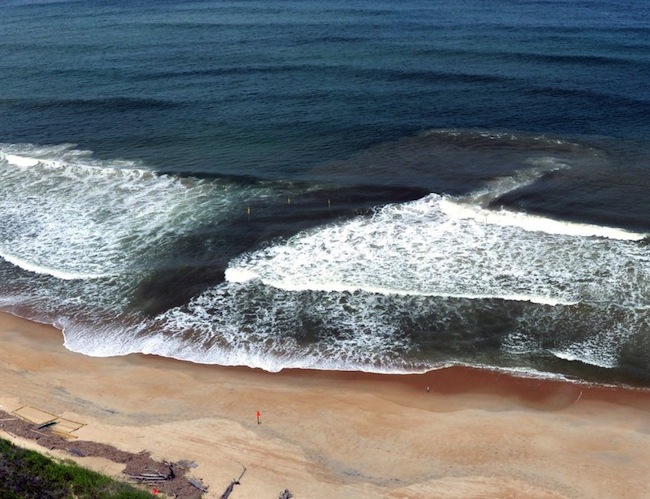One of the books I picked up at the Ways with Words at Dartington was William Thomson’s Book of Tides. This is about the tides around the UK, including the Severn bore, whirlpools and tsunamis (yes, there were tsunamis in the UK in 1755 and 2011).
For me, one of the most interesting chapters was on rip tides. Waves crash onto beaches and the water that flows up the beach has to flow back again, taking the easiest route which may be to either side, or in the middle of the beach, or down any channel which happens to be there. If there is enough of this water, a continuous outward flow forms into a rip. Rips come and go with the state of the tide and can develop very quickly, and even within the Harbour.
Surfers use rips to power them out beyond the waves . But rips are not good for bathers, because they are almost always too fast for even the very best to swim against, which is why each year so many people exhaust themselves and drown in rips. Every family should understand rip tides.
The absolute first rule is never to swim against the current: you can’t; nobody can. You will just exhaust yourself and drown. You should instead swim across the current, along the beach, until you get out of the rip and can then return to the shore (rips are generally no more than 10 metres wide). If you cannot swim out of the current, don’t struggle and don’t panic: conserve your strength by floating. This gives more time for you to be rescued and rips don’t go on for ever. That is why learning to float is central to the RNLI’s latest life-saving campaign.
 But how do you know where the rip is? Curiously, the sea will tell you. Rips are where the waves are least. So the second rule is that the safest place to swim (and swim towards) is where the breaking waves are greatest (how’s that for a paradox?). The place where there are no breaking waves probably has a rip instead: the calmer water is not safer than the waves.
But how do you know where the rip is? Curiously, the sea will tell you. Rips are where the waves are least. So the second rule is that the safest place to swim (and swim towards) is where the breaking waves are greatest (how’s that for a paradox?). The place where there are no breaking waves probably has a rip instead: the calmer water is not safer than the waves.
The third rule is to beware of projections like groynes, particularly if the waves are coming to the beach at an angle. Each projection creates its own rip as the waves strike it and the water is deflected out to sea, so swim in the middle between groynes.
The Book of Tides by William Thomson is published by Quercus (2016) ISBN 978-1-78648-079-8. The picture of a rip tide comes from an excellent blog at www.outerbanksrentals.com
Comments are closed, but trackbacks and pingbacks are open.